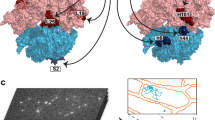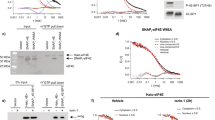Abstract
Protein concentrations are often regulated by dynamic changes in translation rates. Nevertheless, it has been challenging to directly monitor changes in translation in living cells. We have developed a reporter system to measure real-time changes of translation rates in human or mouse individual cells by conjugating translation regulatory motifs to sequences encoding a nuclear targeted fluorescent protein and a controllable destabilization domain. Application of the method showed that individual cells undergo marked fluctuations in the translation rate of mRNAs whose 5′ terminal oligopyrimidine (5′ TOP) motif regulates the synthesis of ribosomal proteins. Furthermore, we show that small reductions in amino acid levels signal through different mTOR-dependent pathways to control TOP mRNA translation, whereas larger reductions in amino acid levels control translation through eIF2A. Our study demonstrates that dynamic measurements of single-cell activities of translation regulatory motifs can be used to identify and investigate fundamental principles of translation.
This is a preview of subscription content, access via your institution
Access options
Subscribe to this journal
Receive 12 print issues and online access
$259.00 per year
only $21.58 per issue
Buy this article
- Purchase on Springer Link
- Instant access to full article PDF
Prices may be subject to local taxes which are calculated during checkout






Similar content being viewed by others
References
Schwanhäusser, B. et al. Global quantification of mammalian gene expression control. Nature 473, 337–342 (2011).
Zong, Q., Schummer, M., Hood, L. & Morris, D.R. Messenger RNA translation state: the second dimension of high-throughput expression screening. Proc. Natl. Acad. Sci. USA 96, 10632–10636 (1999).
Johannes, G., Carter, M.S., Eisen, M.B., Brown, P.O. & Sarnow, P. Identification of eukaryotic mRNAs that are translated at reduced cap binding complex eIF4F concentrations using a cDNA microarray. Proc. Natl. Acad. Sci. USA 96, 13118–13123 (1999).
Kuhn, K.M., Derisi, J.L., Brown, P.O. & Sarnow, P. Global and specific translational regulation in the genomic response of Saccharomyces cerevisiae to a rapid transfer from a fermentable to a nonfermentable carbon source. Mol. Cell. Biol. 21, 916–927 (2001).
Arava, Y. et al. Genome-wide analysis of mRNA translation profiles in Saccharomyces cerevisiae. Proc. Natl. Acad. Sci. USA 100, 3889–3894 (2003).
Ingolia, N.T., Ghaemmaghami, S., Newman, J.R.S. & Weissman, J.S. Genome-wide analysis in vivo of translation with nucleotide resolution using ribosome profiling. Science 324, 218–223 (2009).
Roux, P.P. et al. RAS/ERK signaling promotes site-specific ribosomal protein S6 phosphorylation via RSK and stimulates cap-dependent translation. J. Biol. Chem. 282, 14056–14064 (2007).
Choo, A.Y., Yoon, S.-O., Kim, S.G., Roux, P.P. & Blenis, J. Rapamycin differentially inhibits S6Ks and 4E-BP1 to mediate cell-type-specific repression of mRNA translation. Proc. Natl. Acad. Sci. USA 105, 17414–17419 (2008).
Braunstein, S. et al. A hypoxia-controlled cap-dependent to cap-independent translation switch in breast cancer. Mol. Cell 28, 501–512 (2007).
Elowitz, M.B., Levine, A.J., Siggia, E.D. & Swain, P.S. Stochastic gene expression in a single cell. Science 297, 1183–1186 (2002).
Mukherji, S. et al. MicroRNAs can generate thresholds in target gene expression. Nat. Genet. 43, 854–859 (2011).
Nelson, D.E. et al. Oscillations in NF-κB signaling control the dynamics of gene expression. Science 306, 704–708 (2004).
Tay, S. et al. Single-cell NF-κB dynamics reveal digital activation and analogue information processing. Nature 466, 267–271 (2010).
Iwamoto, M., Björklund, T., Lundberg, C., Kirik, D. & Wandless, T.J. A general chemical method to regulate protein stability in the mammalian central nervous system. Chem. Biol. 17, 981–988 (2010).
Appenzeller-Herzog, C. & Hall, M.N. Bidirectional crosstalk between endoplasmic reticulum stress and mTOR signaling. Trends Cell Biol. 22, 274–282 (2012).
Uetsuki, T., Naito, A., Nagata, S. & Kaziro, Y. Isolation and characterization of the human chromosomal gene for polypeptide chain elongation factor- lα. J. Biol. Chem. 264, 5791–5798 (1989).
Levy, S., Avni, D., Hariharan, N., Perry, R.P. & Meyuhas, O. Oligopyrimidine tract at the 5′ end of mammalian ribosomal protein mRNAs is required for their translational control. Proc. Natl. Acad. Sci. USA 88, 3319–3323 (1991).
Geyer, P.K., Meyuhas, O., Perry, R.P. & Johnson, L.F. Regulation of ribosomal protein mRNA content and translation in growth-stimulated mouse fibroblasts. Mol. Cell. Biol. 2, 685–693 (1982).
Caldarola, S., Amaldi, F., Proud, C.G. & Loreni, F. Translational regulation of terminal oligopyrimidine mRNAs induced by serum and amino acids involves distinct signaling events. J. Biol. Chem. 279, 13522–13531 (2004).
Meyuhas, O. Synthesis of the translational apparatus is regulated at the translational level. Eur. J. Biochem. 267, 6321–6330 (2000).
Tang, H. et al. Amino acid-induced translation of TOP mRNAs is fully dependent on phosphatidylinositol 3-kinase-mediated signaling, is partially inhibited by rapamycin, and is independent of S6K1 and rpS6 phosphorylation. Mol. Cell. Biol. 21, 8671–8683 (2001).
Kurokawa, H. et al. Software for precise tracking of cell proliferation. Biochem. Biophys. Res. Commun. 417, 1080–1085 (2012).
Thoreen, C.C. et al. A unifying model for mTORC1-mediated regulation of mRNA translation. Nature 485, 109–113 (2012).
Liu, Q. et al. Discovery of 9-(6-aminopyridin-3-yl)-1-(3-(trifluoromethyl)phenyl)benzo[h][1,6]naphthyridin-2(1H)-one (Torin2) as a potent, selective, and orally available mammalian target of rapamycin (mTOR) inhibitor for treatment of cancer. J. Med. Chem. 54, 1473–1480 (2011).
Jang, S.K. & Wimmer, E. Cap-independent translation of encephalomyocarditis virus RNA: structural elements of the internal ribosomal entry site and involvement of a cellular 57-kD RNA-binding protein. Genes Dev. 4, 1560–1572 (1990).
Hsieh, A.C. et al. The translational landscape of mTOR signalling steers cancer initiation and metastasis. Nature 485, 55–61 (2012).
Holcik, M. & Sonenberg, N. Translational control in stress and apoptosis. Nat. Rev. Mol. Cell Biol. 6, 318–327 (2005).
Ruvinsky, I. & Meyuhas, O. Ribosomal protein S6 phosphorylation: from protein synthesis to cell size. Trends Biochem. Sci. 31, 342–348 (2006).
Ma, X.M. & Blenis, J. Molecular mechanisms of mTOR-mediated translational control. Nat. Rev. Mol. Cell Biol. 10, 307–318 (2009).
Holcik, M., Sonenberg, N. & Korneluk, R.G. Internal ribosome initiation of translation and the control of cell death. Trends Genet. 16, 469–473 (2000).
Ruvinsky, I. et al. Ribosomal protein S6 phosphorylation is a determinant of cell size and glucose homeostasis. Genes Dev. 19, 2199–2211 (2005).
Meyuhas, O. & Dreazen, A. Ribosomal protein S6 kinase from TOP mRNAs to cell size. Prog. Mol. Biol. Transl. Sci. 90, 109–153 (2009).
Le Bacquer, O. et al. Elevated sensitivity to diet-induced obesity and insulin resistance in mice lacking 4E-BP1 and 4E-BP2. J. Clin. Invest. 117, 387–396 (2007).
Damgaard, C.K. & Lykke-Andersen, J. Translational coregulation of 5′TOP mRNAs by TIA-1 and TIAR. Genes Dev. 25, 2057–2068 (2011).
Hafner, M. et al. Transcriptome-wide identification of RNA-binding protein and microRNA target sites by PAR-CLIP. Cell 141, 129–141 (2010).
Ule, J. et al. CLIP identifies Nova-regulated RNA networks in the brain. Science 302, 1212–1215 (2003).
Kishore, S. et al. A quantitative analysis of CLIP methods for identifying binding sites of RNA-binding proteins. Nat. Methods 8, 559–564 (2011).
Acknowledgements
We thank F.-C. Tsai, a former graduate student of the Meyer lab, for the original Matlab code that was modified and used here to track single cells in the movies. The tunable ecDHFR plasmid was provided by T. Wandless (Stanford University). K.H. was supported by Stanford Graduate Fellowship. The work was supported by US National Institutes of Health grant GM030179.
Author information
Authors and Affiliations
Contributions
K.H. designed the reporter and the experiments, performed the experiments and analyzed the data. A.J. performed RNA FISH and provided the Matlab script to analyze the RNA FISH data. G.D. contributed to the development of the reporter. N.S. and O.M. provided MEFs. K.H. and T.M. interpreted the results and wrote the manuscript. All authors discussed the results and the manuscript. T.M. supervised the study.
Corresponding authors
Ethics declarations
Competing interests
The authors declare no competing financial interests.
Supplementary information
Supplementary Text and Figures
Supplementary Figures 1–11 (PDF 6706 kb)
Rights and permissions
About this article
Cite this article
Han, K., Jaimovich, A., Dey, G. et al. Parallel measurement of dynamic changes in translation rates in single cells. Nat Methods 11, 86–93 (2014). https://doi.org/10.1038/nmeth.2729
Received:
Accepted:
Published:
Issue Date:
DOI: https://doi.org/10.1038/nmeth.2729
This article is cited by
-
Nucleotide imbalance decouples cell growth from cell proliferation
Nature Cell Biology (2022)
-
Quantification of mRNA translation in live cells using single-molecule imaging
Nature Protocols (2020)
-
A post-transcriptional program of chemoresistance by AU-rich elements and TTP in quiescent leukemic cells
Genome Biology (2020)
-
Honokiol inhibits breast cancer cell metastasis by blocking EMT through modulation of Snail/Slug protein translation
Acta Pharmacologica Sinica (2019)



